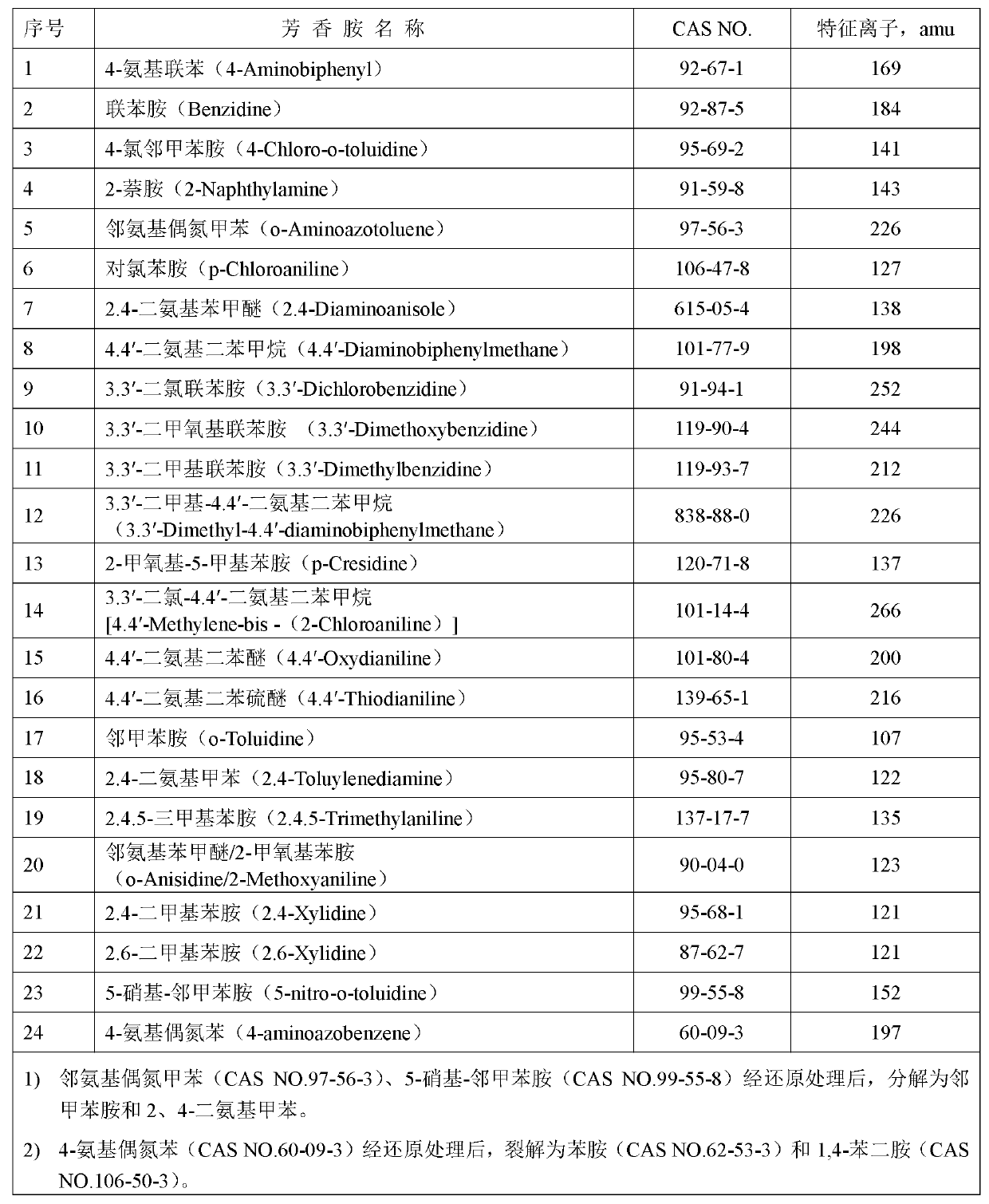Method for quickly screening and detecting azo dyes forbidden in textile materials, leathers and dyes using gas chromatography mass spectrometry
A gas chromatography and azo-free technology, applied in the field of chemical analysis and detection, can solve the problems of large detection scale, high reagent consumption, low positive rate, etc., achieve the effect of large consumption of reagents and materials, and shorten the processing time
- Summary
- Abstract
- Description
- Claims
- Application Information
AI Technical Summary
Problems solved by technology
Method used
Image
Examples
Embodiment 1
[0079] Embodiment 1: Actual sample detection
[0080] (1) Reagent preparation:
[0081] Sodium citrate buffer (0.06 mol / L, pH=6): Take 12.526 g of citric acid and 6.320 g of sodium hydroxide, dissolve in water, and dilute to 1000 mL.
[0082] 20 mg / L 2,4,5-trichloroaniline internal standard working solution: Dissolve 20 mg 2,4,5-trichloroaniline in ethyl acetate, and dilute to 1000 mL.
[0083] 2 mg / L 2,4,5-trichloroaniline internal standard working solution: draw 1 mL of 2,4,5-trichloroaniline internal standard working solution with a concentration of 20 mg / L into a 10 mL volumetric flask, and use Dilute to the mark with ethyl acetate and mix well.
[0084] 22 kinds of aromatic amine standard substance concentrations are 20 mg / L mixed standard working solution: 24 kinds of prohibited aromatic amine standard substances (shown in Table 1) except o-aminoazotoluene, 5-nitro - 21 kinds of prohibited aromatic amine standard substances and aniline except o-toluidine and 4-aminoaz...
Embodiment 2
[0110] Embodiment 2: Detection of 4-aminoazobenzene
[0111] Using the method of the present invention, although o-aminoazotoluene and 5-nitro-o-toluidine can be further decomposed and difficult to be directly detected, they can be decomposed by a detector to produce o-toluidine and 2,4-diaminotoluene in the form of Indirect method detection. For 4-aminoazobenzene, the amount of aniline detected by the detection method of the present invention is used to determine whether to further use the existing 4-aminoazobenzene detection standard for detection.
[0112] Table 5 Contains 4-aminoazobenzene positive sample to detect aromatic amine value through detection method of the present invention and standard method
[0113]
[0114] At present, the limit of 4-aminoazobenzene in the European Union is 30 mg / kg, and the limit of 4-aminoazobenzene in my country is stricter - 20 mg / kg. In Table 5, when the content of 4-aminoazobenzene is lower than 20 mg / kg, its decomposition product...
Embodiment 3
[0115] Embodiment 3: comparison of technical parameters
[0116] Table 6 Comparison of technical parameters for the detection of prohibited azo dyes in samples
[0117]
[0118] Through the standard recovery test and the analysis of Examples 1-2, the method of the present invention can be used as 14 standards such as the detection of azo dyes and the detection of 4-aminoazobenzene in 3 types of products commonly used at home and abroad, such as textiles, leather and dyes. Compared with the standard method, the method of the present invention has the advantages of high sensitivity, high recovery rate and high extraction efficiency.
[0119]Through the comparison of the method of the present invention in Table 6 with the representative EU standard EN 14362:2003 on the technical parameters of sample pretreatment, it is found that the method of the present invention also has the following advantages: 1), single-sample detection cost (excluding The labor cost saved) was reduced...
PUM
| Property | Measurement | Unit |
|---|---|---|
| Concentration | aaaaa | aaaaa |
Abstract
Description
Claims
Application Information
 Login to View More
Login to View More - R&D
- Intellectual Property
- Life Sciences
- Materials
- Tech Scout
- Unparalleled Data Quality
- Higher Quality Content
- 60% Fewer Hallucinations
Browse by: Latest US Patents, China's latest patents, Technical Efficacy Thesaurus, Application Domain, Technology Topic, Popular Technical Reports.
© 2025 PatSnap. All rights reserved.Legal|Privacy policy|Modern Slavery Act Transparency Statement|Sitemap|About US| Contact US: help@patsnap.com



